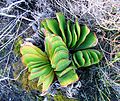Kumara (plant)
| Kumara | |
|---|---|

| |
| Fan-aloe, Kumara plicatilis | |
| Scientific classification | |
| Kingdom: | Plantae |
| Clade: | Tracheophytes |
| Clade: | Angiosperms |
| Clade: | Monocots |
| Order: | Asparagales |
| Family: | Asphodelaceae |
| Subfamily: | Asphodeloideae |
| Tribe: | Aloeae |
| Genus: | Kumara Medik., nom. cons.[1] |
| Type species | |
| Kumara disticha | |
Kumara is a genus of two species of flowering plants in the subfamily Asphodeloideae, native to the Western Cape Province of South Africa.[2][3]
Separation from Aloe
Phylogenetic studies indicated that two species that were traditionally classed as members of the genus Aloe were genetically distinct and comprised an entirely separate clade. The species were accordingly split off as a separate genus, given the name that it had previously held, Kumara.[4] Both species bear characteristically strap-shaped leaves in a two-ranked (orthodistichous) arrangement.[5]
Intergeneric hybrids have nonetheless been recorded, between Kumara and at least one other alooid genus, Gonialoe. The resulting hybrid, initially published as an infrageneric hybrid between two species of Aloe, is now designated an intergeneric hybrid of the new nothogenus × Gonimara.[6]
Species
Two species are accepted, as of October 2017[update]:[1]
| Image | Scientific name | Distribution |
|---|---|---|
 |
Kumara haemanthifolia (Marloth & A.Berger) Boatwr. & J.C.Manning, syn. Aloe haemanthifolia[7] | Western Cape, South Africa |
 |
Kumara plicatilis (L.) G.D.Rowley, syn. Aloe plicatilis[8] | Western Cape, South Africa |
Both species have a unique distichous ("fan") arrangement to their grey, strap-shaped leaves. Both are also indigenous to roughly the same range of mountains in the south-western corner of the Western Cape, South Africa, however the tall tree-like Kumara plicatilis is found on the lower slopes of the mountains, while the tiny stemless Kumara haemanthifolia inhabits the high peaks.
References
- ^ a b "Search for Kumara". World Checklist of Selected Plant Families. Royal Botanic Gardens, Kew. Retrieved 2017-10-14.
- ^ http://biotaxa.org/Phytotaxa/article/view/phytotaxa.115.2.5
- ^ "The Aloe Page - Aloaceae".
- ^ Daru, Barnabas (5 February 2014). "An augmented molecular phylogeny and classification of Asphodelaceae subfamily Alooideae: Towards a resolution of the prickly issue of polyphyly in the alooids". Systematic Botany.
- ^ Molteno S (2022) "Phyllotaxis in Asphodelaceae subfam. Alooideae: a tool in taxon delimitation." Haseltonia 28(1), https://doi.org/10.2985/026.028.0107
- ^ "Smith GF, Figueiredo E, Molteno S (2018) "×Gonimara Gideon F.Sm. & Molteno (Asphodelaceae): a new nothogenus name for the artificial hybrid, ×Gonimara corderoyi (A.Berger) Gideon F.Sm. & Molteno, between the alooid species Gonialoe variegata and Kumara plicatilis, two southern African endemics". Bradleya 36, 51-58". Archived from the original on 2018-09-06. Retrieved 2018-09-06.
- ^ "Threatened Species Programme | SANBI Red List of South African Plants".
- ^ "Threatened Species Programme | SANBI Red List of South African Plants".
- Articles with short description
- Short description is different from Wikidata
- Articles needing cleanup from August 2022
- Articles with bare URLs for citations from August 2022
- All articles with bare URLs for citations
- Articles covered by WikiProject Wikify from August 2022
- All articles covered by WikiProject Wikify
- Articles with 'species' microformats
- Articles containing potentially dated statements from October 2017
- All articles containing potentially dated statements
- Commons category link is on Wikidata
- Asphodelaceae genera
- Asphodeloideae
- All stub articles
- Asphodelaceae stubs